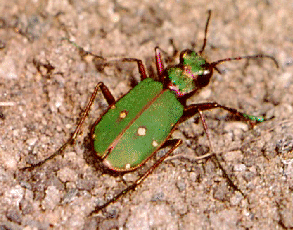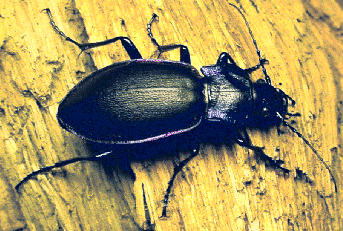
Consulting Entomologist

Tel/Fax: 01275 854224
E-Mail: [email protected]
Site Guide
Site Search
Home Page
Career Page
Insect Files
- Contents
- Bug Index
- The World of Bugs
- Classification of Bugs
- Insect Identification
- Insect Fossils
- Insect Body-parts
- Micro View of Bugs
- Insect Life Cycles
- Insect Defences
- Insects of Nailsea
- Pesticide Safety
- Bibliography
Shortcut to the main groups of insects and other arthropods...
Bug Rhymes & Poems
Links
Shop
Payments (credit/debit card)
Ground Beetles & Tiger Beetles |
Class: Insecta Order: Coleoptera | |
|
The large 'black-clock' beetles, 10-20 mm long, often seen scampering
across the A typical black ground beetle (Pterostichus melanarius) found commonly in gardens and farmland where it preys on aphids, caterpillars, wireworms, slugs and other pests (actual size 12-18 mm long) The Carabidae, or ground beetles, are one of the largest and best known families of beetles (Coleoptera), with over 20,000 different species worldwide - about 340 of these occur in Britain. Most species are nocturnal and sombrely coloured black or brown, but a few display iridescent and metallic blue, bronze, green or reddish reflections, and the family also includes the brightly coloured, and mainly diurnal, tiger beetles. 
The common green tiger beetle (Cicindela campestris) found on heaths and sandy places (actual size 12-16 mm long) Carabid beetles and their larvae are mostly carnivorous, although some probably also scavenge on the dead remains of insects and other invertebrates, whilst others feed extensively on vegetable matter, especially plant seeds. A few of the carnivores are specialized caterpillar or snail hunters, or prey on a fairly narrow range of small animals such as aphids, springtails and mites; but most species are not very fastidious and a mixed diet of many different invertebrates, and often some vegetable matter, is quite normal. One or two carabids are occasional pests, such as the strawberry seed beetle (Harpalus rufipes), which sometimes damages strawberries by biting at the seeds and surrounding flesh, and the cereal beetle (Zabrus tenebrioides), which in some parts of Europe damages cereal crops by feeding on the leaves and developing ears of corn. Otherwise, the vast majority of ground beetles are extremely beneficial and important predators which help in the natural control of many garden and crop pests, such as grasshoppers, crickets, termites, aphids, plant bugs, leaf beetles, weevils, wireworms, chafer grubs, butterfly and moth caterpillars, sawfly caterpillars, crane flies (leatherjackets), fruit flies, gall midges, many other fly pests, as well as slugs and snails. | ||
|
|
|
Relatively little is known about the life history and habits of most ground beetles. Some appear to breed in late summer and autumn, and then hibernate as larvae through the winter. Others (probably the majority) hibernate as adults and reproduce in spring or early summer, after which the beetles usually die off and a new generation appears in autumn ready for overwintering again. The development of larvae and the survival of adult beetles sometimes lasts more than one year. After emerging in spring, the adults of a few species undergo a summer resting period (called aestivation or diapause) before they start egg-laying in autumn. Ground beetles usually lay eggs on the ground or just below the soil surface and go through three larval stages (instars) before pupating and emerging as adults. Most ground beetles hunt and disperse over short distances by walking and climbing, but the adults of many species are also capable of flight - a few, like tiger beetles, readily take flight in their daily search for food or to escape enemies. Drawing of typical carabid larva (Pterostichus) If roughly handled or attacked, nearly all carabid beetles may discharge an obnoxious, volatile and highly irritant fluid, sometimes quite forcibly, from glands in the tip of the abdomen, and many species also regurgitate unpleasant gut fluids from the mouth. Some species, if disturbed and agitated, also produce an audible squeak or buzzing sound. These various mechanisms are thought to serve in defence against natural enemies, such as insectivorous mammals and birds. Large carabids can also inflict a sharp nip with their powerful jaws - so, all round it is best to avoid handling these beetles. Some household and garden insecticides are potentially toxic to the beneficial species of ground beetles. In general, carabid larvae are more susceptible to pesticides than adults, and smaller beetles are usually more sensitive than larger species. If you have to use insecticides, remember to choose the more selective and/or less persistent products which minimise harm to beneficial insects. |
|
MORE ON BEETLES Order Coleoptera <<< HERE >>> |
| <<< TOP | (use the back button on your web browser to return to the previous page) | TOP >>> |
